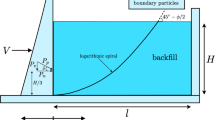Abstract
An appreciation of the physical mechanisms which cause observed seismicity complexity is fundamental to the understanding of the temporal behaviour of faults and single slip events. Numerical simulation of fault slip can provide insights into fault processes by allowing exploration of parameter spaces which influence microscopic and macroscopic physics of processes which may lead towards an answer to those questions. Particle-based models such as the Lattice Solid Model have been used previously for the simulation of stick-slip dynamics of faults, although mainly in two dimensions. Recent increases in the power of computers and the ability to use the power of parallel computer systems have made it possible to extend particle-based fault simulations to three dimensions. In this paper a particlebased numerical model of a rough planar fault embedded between two elastic blocks in three dimensions is presented. A very simple friction law without any rate dependency and no spatial heterogeneity in the intrinsic coefficient of friction is used in the model. To simulate earthquake dynamics the model is sheared in a direction parallel to the fault plane with a constant velocity at the driving edges. Spontaneous slip occurs on the fault when the shear stress is large enough to overcome the frictional forces on the fault. Slip events with a wide range of event sizes are observed. Investigation of the temporal evolution and spatial distribution of slip during each event shows a high degree of variability between the events. In some of the larger events highly complex slip patterns are observed.
Access this chapter
Tax calculation will be finalised at checkout
Purchases are for personal use only
Preview
Unable to display preview. Download preview PDF.
Similar content being viewed by others
References
Abe, S., Place, D., and Mora, P. (2004), A parallel implementation of the lattice solid model for the simulation of rock mechanics and earthquake dynamics. Pure Appl. Geophys. 161, (9/10).
Aki, K. and Richards P. G. Quantitative Seismology, Theory and Methods (Freeman and Company, San Francisco 1980).
Ben-Menahem, A. and Singh, S. J., Seismic Waves and Sources, (Springer-Verlag, New York 1981).
Ben-Zion, Y. (2001), On Quantification of the Earthquake Source, Seis. Res. Lett., 72, 151–152.
Ben-Zion, Y. and Rice, J. R. (1993), Earthquake failure sequences along a Cellular Fault Zone in a Three-Dimensional elastic Solid Containing Asperity and Nonasperity Regions, J. Geophys. Res., 98, 14109–14131.
Ben-Zion, Y. and Rice, J. R. (1995), Slip patterns and earthquake populations along different classes of faults in elastic solids, J. Geophys. Res. 100, 12959–12983.
Beroza, G. C. and Mikumo, T. (1996), Short slip duration in dynamic rupture in the presence of heterogeneous fault properties, J. Geophys. Res. 101B10, 22449–22460.
Cochard, A. and Madariaga, R. (1996). Complexity of seismicity due to highly rate dependent friction, J. Geophys. Res. 101B11, 25321–25336.
Cundall, P.A. and Strack, O.D.A. (1979), A discrete numerical model for granular assemblies, Geóotechnique, 29, 47–65.
Das, S. and Aki, K. (1977), Fault plane with barriers: A versatile earthquake model, J. Geophys. Res. 82, 5658–5670.
Gross, S. (1996), Magnitude distribution and slip scaling of heterogeneous seismic source, Bull. Seismol. Soc. Am. 86, 498–504.
Heimpel, M. H. (2003), Characteristic scales of earthquake rupture from numerical models, Nonlinear Processes in Geophys, 10, 573–584.
King, G.C.P. (1978), Geological faults: fracture, creep and strain, Phil. Trans. R. Soc. Lond. A, 288, 197–212.
Latham, S., Abe, S., and Davies, M. (2004), Scaling evaluation of the lattice solid model on the SGI Altix 3700, HPCAsia2004, Proceed. 7th Internat. Conf. on High Performance Computing and Grid in the Asia Pacific Region, 226–233.
Langer, J.S., Carlson, J. M., Myers, C.R. and Shaw, B. E. (1996), Slip Complexity in dynamic models of earthquake faults, Proc. Nat. Acad. Sci. USA, 93, 3825–3829.
Madariaga, R. and Cochard, A. (1996), Dynamic friction and the origin of the complexity of earthquake sources, Proc. Nat. Acad. Sci. USA, 93, 3819–3824.
Mora, P. and Place, D. (1994), Simulation of the stick-slip instability, Pure Appl. Geophys. 143, 61–87.
Mora, P. and Place, D. (1998), Numerical simulation of earthquake faults with gauge: towards a comprehensive explanation for the low Heat Flow, J. Geophys. Res. 103, 21067–21089.
Nielsen, S. B., Carlson, J. M. and Olsen, K. B. (2000), Influence of friction and fault geometry on earthquake rupture, J. Geophys. Res. 105,B3, 6069–6088.
Place, D. and Mora, P. (1999). The lattice solid model to simulate the physics of rocks and earthquakes: incorporation of friction, J. Comp. Physics, 150, 332–372.
Place, D and Mora, P. (2001). A random lattice solid model for simulation of fault zone dynamics and fracture processes. In Bifurcation and Localisation Theory for Soils and Rocks'99 (eds. H. B. Mühlhaus, A. Dyskin and E Pasternak) (AA Balkema Rotterdam/Brookfield 2001).
Power, W. L., Tullis, T. E. and Weeks, J. D. (1988), roughness and wear during brittle faulting, J. Geophys. Res. 93, 15268–15278.
Power, W. L. and Tullis T. E. (1991), Euclidean and fractal models for the description of rock surface roughness, J. Geophys. Res. 96, 415–424.
Rice, J. R. (1993), Spatio-temporal complexity on a fault, J. Geophys. Res. 98, 9885–9907.
Rice, J. R. and Ben-Zion Y. (1996), Slip complexity in earthquake fault models, Proc. Nat. Acad. Sci. USA, 93, 3811–3818.
Weatherley, D. and Abe, S. (2004), Earthquake statistics in a block slider model and a fully dynamic fault model. Nonlinear Processes in Geophys., 11, 553–560.
Zöller, G., Holschneider, M., and Ben-Zion, Y. (2005), The role of heterogeneities as a tuning parameter of earthquake dyanmics, Pure Appl. Geophys., 162, 1077–1111.
Author information
Authors and Affiliations
Editor information
Editors and Affiliations
Rights and permissions
Copyright information
© 2006 Birkhäauser Verlag
About this paper
Cite this paper
Abe, S., Latham, S., Mora, P. (2006). Dynamic Rupture in a 3-D Particle-based Simulation of a Rough Planar Fault. In: Yin, Xc., Mora, P., Donnellan, A., Matsu’ura, M. (eds) Computational Earthquake Physics: Simulations, Analysis and Infrastructure, Part I. Pageoph Topical Volumes. Birkhäuser Basel. https://doi.org/10.1007/978-3-7643-7992-6_10
Download citation
DOI: https://doi.org/10.1007/978-3-7643-7992-6_10
Received:
Revised:
Accepted:
Publisher Name: Birkhäuser Basel
Print ISBN: 978-3-7643-7991-9
Online ISBN: 978-3-7643-7992-6
eBook Packages: Earth and Environmental ScienceEarth and Environmental Science (R0)




